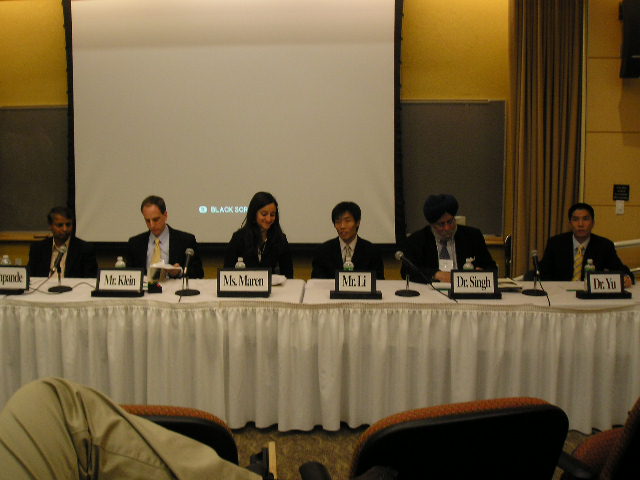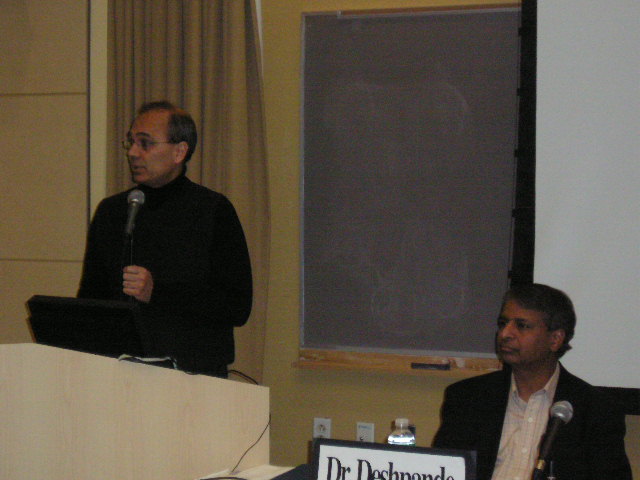Contribute
| Asia Rising Giants - China And India |
Anil Saigal
03/08/2007
The Tufts Institute of Global Leadership hosted a four-day conference on Asia’s Rising Giants: China and India from Feb. 22-25, 2007 at the ASEAN Auditorium at Tufts University, Medford, MA. The organization team consisted of Marissa Maren, Tara Dhawan and others. Some of the leading panelists included Pramit Mitra, Tarun Khanna, Mohan Malik, Surjit Mansingh, Inderjit Singh, A.R. Ghanashyam, Desh Deshpande, Chietigj Bajpaee, Anupam Srivastava, Nimmi Kurian, and Kingshuk Chatterjee. The sessions dealt with Fighting the Tide: Responding to Pandemics, Asia’s Rising Giants: Global Implications, Presenting a Greener Future: Environmental Sustainability, Education and Entrepreneurship: Are Asia’s Top Minds Thinking Outside the Box? and Security Implications for the Regional and Global Arenas.
A.R. Ghanashyam, Deputy Consul General, Consulate General of India, New York, mentioned that in 1947 the India economy consisted of 70% agriculture, 10% industrial and 20% service. Today agriculture accounts for 30%, industry for 23% and service sector 55%. The dominant South Asian countries including Japan, Korea and China, have a strong manufacturing base and as such India needs to increase its manufacturing output to keep up with the needs of the citizens entering the work force. The IT industry cannot do it alone. However, he stressed that a 2-5 degree rise in global temperature will have serious implications for India and could reduce the rice crop by 20-50% ad wheat crop by 35-60%. India has a comprehensive plan and plans to increase its forest area from 25 to 33% by 2012. “India meets half its energy demand from coal and US can help by making available all technologies which reduce emission at discount to developing countries,†said Ghanashyam.
Neeraj Doshi emphasized that caring for the environment is a luxury of the well-fed and discussed the S3idf approach which included a social merchant bank, developing bankability of clean energy projects and overcoming collateral constraints to promote increased use of alternative energies.
Inderjit Singh, Professor of Political Economy and National Security, National War College, Formerly with World Bank, compared the literacy rates (90+% for China vs. 60% for India) and the health expenditure per capita (China - $70, India - $25). “China is the most inefficient system in the world in term of capital utilization,†said Singh. Constraints to future growth for both countries included energy, water shortages and corruption. In addition, China has to deal with rural unrest, banking crisis, role of party and lack of freedom. India’s additional constraints include rural poverty, poor infrastructure, slow reforms domestic insurgencies and ineffective implementation.
Desh Deshpande, CEO, Sycamore Networks, discussed Education and Entrepreneurship at three levels. At the top level, he mentioned the IITs and IIMs and the new world-class initiative Public Health Foundation of India. In the middle, he talked about those who have the ability to think and can be trained by the various organizations on site. “For the bottom, we need best practices and talent to solve big problems,†said Deshpande.
Kingshuk Chatterjee, Fulbright Scholar-in-Residence, US Naval Academy, Lecturer, Department of History, Scottish Church College, Kolkata, said, “The strength of the state should not be the strength of the government, but rather the strength of the people.†He preferred to use the term ‘rise’ rather than ‘giant’ for India while emphasizing the low per capita income and uneven distribution of wealth.
You may also access this article through our web-site http://www.lokvani.com/

